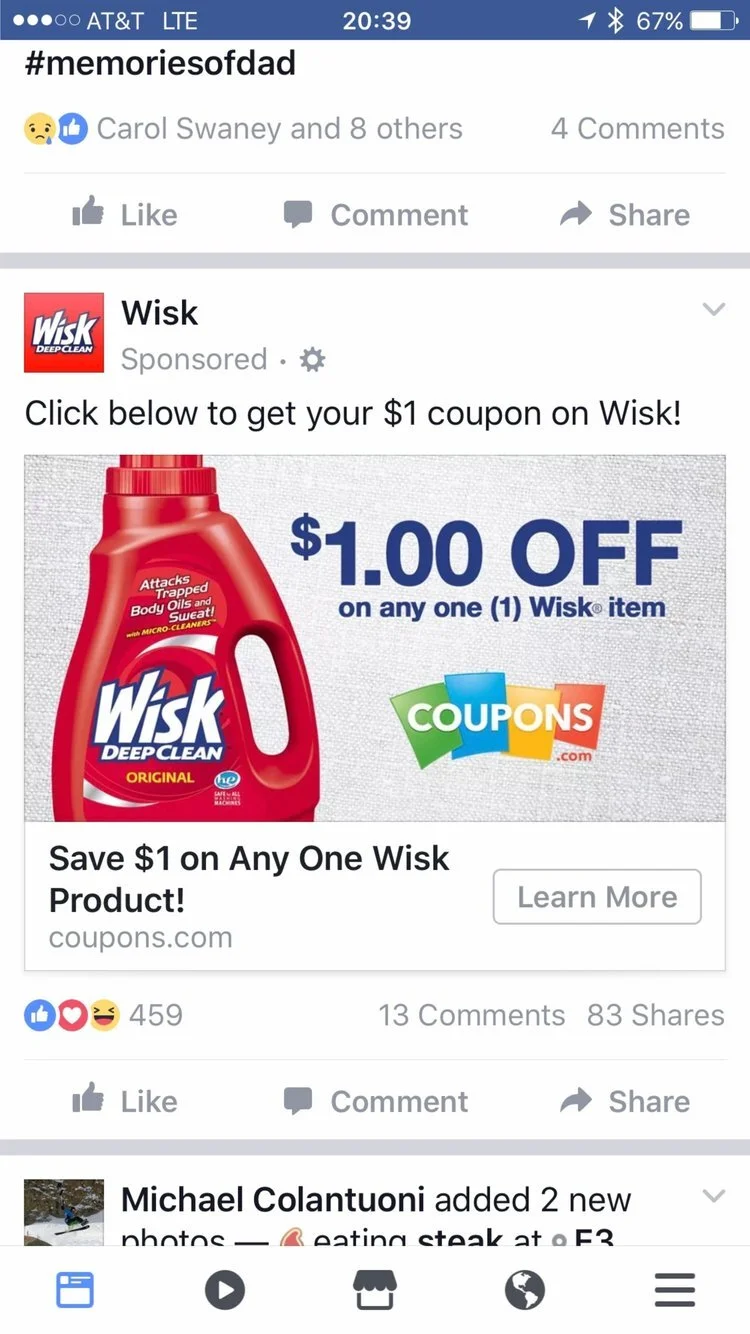Sam Walton Had It Right, Retail Gimmicks Suck!! ~via @PrevailingPath Co-Founder @Katadhin
Endless 'Deals' in an Age of Retail Transparency Are Bad for Consumers and Bad for Brands
One of Sam Walton's rules for building a great business was, "Swim upstream. Go the other way. Ignore the conventional wisdom". It was my favorite quote and I often think about it when considering business strategy. We've reached an inflection point in digital marketing that Mr. Walton would appreciate as many marketing folks are swimming the same direction. Discounts, deals, specials and all manner of retail gimmicks are seeking to break through the crushing digital noise layer, mostly all aimed at the same consumers through magic targeting schemes. The problem is, to the consumer, much of digital marketing resembles their now useless email inbox. Plus, shoppers are now trained by an endless cycle of discounts and come ons to wait because there will be a better deal soon and also to ask themselves a simple question, why the heck would I ever buy anything full price? An even better question for marketers, why not sell a good product at a fair price and follow Sam's advice?
A couple weeks ago I received a sponsored Wisk coupon in my Twitter feed. Why the hell any marketer put a paid freaking coupon in my Twitter feed is completely baffling to me. I use Twitter for news, relationship building and learning more about Shopper Marketing industry trends, so the very last thing on earth I want in my feed is a coupon for laundry detergent. Anyone seeking to build brand equity and warmth should realize that this is a bad idea. Just 3% of consumers report wanting to receive coupons and discounts through social media according to a PWC report. One of the maxims of digital marketing needs to be, just because you CAN advertise to someone, doesn't mean you SHOULD!
Just because you CAN advertise to someone, doesn't mean you SHOULD!
One of the biggest problems facing digital media is old marketing tactics being combined with new technology. Interruption marketing sucked then and it really sucks now that much of our media is less passive and more active. Programatic targeting works because if you show enough people ads enough times you'll eventually convert a sale, but at what cost to brand equity and what is the quality of the shopper? Are marketers simply converting deal seekers while valuable long-term loyal customers are shifting their consumption behavior? Consumers HATE brands stalking them around their digital paths simply because they've searched for an item or discussed it in an email. In the rush to convert sales, many brands effectively feel like one night stands for consumers.
Buy our stuff. Buy our stuff! BUY OUR STUFF!!! Thanks, peace out.
Once again, I believe much of this has to do with the fact that the digital team and brand team aren't integrated and aligned and its very dangerous for brands. The idea that you can still segment customers in different conversations with incomplete information driven from the brand side and different channels is simply false. Consumers are smart, empowered and armed with new tools that help then ferret out margin destroying deals no matter where they are in the shopping process.
Mr. Sam said, "You can make a lot of mistakes and still recover if you run an efficient operation. Or you can be brilliant and still go out of business if you're too inefficient." He couldn't stand inefficiency. He looked at the retail industry and saw all kinds of games that made the real price of a product almost impossible to decipher. Slotting fees, chargebacks of all manner, cooperative marketing funding, coupons etc. all created obfuscation for suppliers and retailers which created a poor experience for shoppers. Sam flipped the script and had all his suppliers give him their absolute rock bottom price and then he in turn gave that to his customers. Simple right? This approach helped create the largest retailer in the world because shoppers flocked in as they built trust that the Walmart approach would simply give them the lowest overall price for a basket of goods. They also told their friends and family driving spectacular growth. All of the retail game playing, circular comparisons, coupon clipping, double discount Wednesday's and sales gimmicks of all types was simply a tradeoff in consumer time and attention and could be avoided. They could simply shop for great deals. Duh!
Inefficiency seems to be the current state of digital marketing as the reality of content shock descends on the industry. In the face of rising volume of media and declining engagement across the digital spectrum, the answer seems to be shopper gamification. More and more marketing with increasing levels of 'smartness' (aka device level targeting) all resulting in a vicious cycle of consumer annoyance and diminishing returns. The entire industry seems running headlong into the open arms of big data as if it is some sort shortcut to doing the real work of marketing. I've seen digital conversion pitches citing 4X industry click rates. Woohoo, industry norms are .06% and falling, so at that astounding performance level 99.76% of people ignore, avoid and block your ad. Precision targeting makes it worse, Mom doesn't want your meal ideas email, popup or text at 1:00 PM just because you know that she doesn't have a meal planned (gmail to her husband mentioned 'what should we do for dinner) and because you know she has soup coupons connected to her loyalty app. She can find her own ideas just fine on her private whatsapp mom group, thank you very much. Once again, just because you CAN advertise to someone, doesn't mean you SHOULD!
Be Lazy, Get Discounts
Tools like Honey are making it effortless for shoppers to receive every available discount without doing anything other than using their browser. In the example above, before I even login to Hertz, Honey is already apprising me of discounts codes. Many discount and rebate schemes rely on a fair amount of breakage with consumers forgetting to use them at the time of purchase or shifting to another product that isn't eligible for the discount. Instantly redeemable coupons (IRCs) have a conversion rate of 18% to 41% depending on category which dwarfs rates of conversion for other coupons types that have fallen well below .08% on average despite regular increases in distribution over the past few years. IRCs are on the product a consumer is buying and they don't even get used but are effective at driving planned and unplanned purchases as well as brand switching. This low volume of actual usage even at the point of sale illustrates that like digital couponing, much of discounting is spam and appeals mainly to deal seeking shoppers and is not really helping brands. It simply adds to the omnichannel noise level. Well over 350 billion coupons are now issued annually in the US with less than 3 billion redeemed. This is the pure definition of spam.
There is no doubt that some consumers love coupons and discounting, however as shopping moves toward more friction free delivery, do discounting activities simply get in the way of efficient shopping. A better consumer experience would be just selling things at a fair price to all consumers and stop playing games with the shopping process, especially with digital channels. Sam Walton created simple shopping when he developed his Everyday Low Price (EDLP) strategy. By removing all of the backend costs to brands including coupons, his suppliers could give Walmart their very best price which Walmart passed along to consumers. Consumers in turn realized that it was easy to get the lowest total basket price at Walmart and built trust shopping its stores vs. paying changing prices and collecting coupons at its competitors. This idea is once again highly relevant as shopping continues to shift to digital channels. Specific channels become less important to consumers as they seek to fill their wants and needs in the most simple way possible, in fact simple may well be the new order winner for a majority of shoppers. Great trust can be built by helping consumers know they will pay the lowest prevailing price without having to work hard at verifying that fact. Honey and its ilk are going to help consumers pay the lowest price anyway, why not just make it easy for them?
The pursuit of customers through aggressive deals is taking a huge toll on retailer and brand profitability. For the 2016 holiday season, upwards of 40% of all sales were discounted. This causes a wealth of confusion for consumers as is reinforces their growing habit of delaying purchases based on expectations of deeper discounting. Worse for brands and retailers is extreme impact on margins which is evidenced by the wreckage of retail sector values over the past year. Walking dead zombie retailers aren't helping either as they add to the overall discounting pressure through unsold goods that go to market below price to extend the inevitable. The pressure to create relevancy will no doubt lead to further discounting and rising volumes of consumer come ons.
Great brands don't discount, they don't need to. When is the last time you saw a coupon or a buy one get one offer for an Apple product? Pricing (including discounts) is now easily visible to all consumers. Make a great product, sell it at a fair price and take care of consumers instead of signaling that your product isn't worth paying full price for in the first place.





